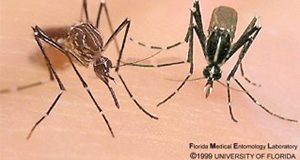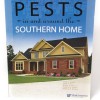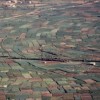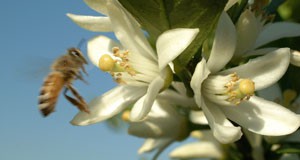Doveweed is a common warm-season annual weed in Florida landscapes, container nurseries, and other agricultural production systems. This new 5-page article is written for green industry professionals and others to aid in the identification and management of doveweed in and around ornamental plants. Preemergence and postemergence herbicides are covered, as well as basic information on doveweed biology and growth. Written by Yuvraj Khamare, Chris Marble, Nathan Boyd, and Shawn Steed, and published by the UF/IFAS Environmental Horticulture Department.
https://edis.ifas.ufl.edu/ep576
Tag: Integrated Pest Management
Weeds as Reservoirs of Plant Pathogens Affecting Economically Important Crops
Weeds are a major contributor to yield loss and reduction in yield quality in an agricultural setting, competing with the crop for resources like light, water, and nutrients. This competition, along with the cost of weed management strategies like tillage and herbicides, is responsible for the economic impact of weeds, which can reach into the billions. Weeds can also harm crop plants by acting as reservoirs for destructive plant pathogens, the insect vectors that move these pathogens from plant to plant, or both. This new 7-page publication of the UF/IFAS Horticultural Sciences Department, written by Morgan Byron, Danielle Treadwell, and Peter Dittmar, summarizes previously published weed-pathogen associations to help growers scout and monitor pathogens in weeds near production areas.
https://edis.ifas.ufl.edu/hs1335
Key Plant, Key Pests: Juniper (Juniperus spp.)
This series of Key Plant, Key Pests publications is designed for Florida gardeners, horticulturalists, and landscape professionals to help identify common pests associated with common Florida flora. This seven-page publication, the ninth in the Key Plant, Key Pests series, helps identify the most common pests found on Juniper, with information and general management recommendations for bagworms, eriophyid mites, scale, spider mites, webworm, mushroom root rot, needle blight, Rhizoctonia web blight, tip blight, and wet root rot diseases. Written by Juanita Popenoe, Jacqueline Bourdon, Caroline R. Warwick, and Alfred Huo and published by the UF/IFAS Environmental Horticulture Department.
http://edis.ifas.ufl.edu/ep570
How to Quantify Nosema Spores Infection Rate in a Honey Bee Colony
Nosema are single-celled fungal parasites that infect various animal hosts. One species, Nosema ceranae, has become the dominant microsporidian infection in western honey bee colonies. When honey bees ingest Nosema spores, many eventually starve to death because the spores replicate in the stomach and hijack the bee’s nutrition. The risk of Nosema infection can be particularly unsettling to beekeepers because colonies often do not show signs of infection until the colony is severely diminished.
This 5-page fact sheet written by Ashley N. Mortensen, Cameron J. Jack, Meghan McConnell, Liana Teigen, and Jamie Ellis and published by the Department of Entomology and Nematology explains how to diagnose and quantify Nosema infection in a honey bee colony.
http://edis.ifas.ufl.edu/in1123
Zika Vector Control for the Urban Pest Management Industry

Zika is a mosquito-transmitted virus that has recently spread to the Americas. Zika virus (ZIKV) was discovered in 1946 in Africa where it was isolated from a Rhesus monkey in the Zika forest of Uganda. In 2007, a disease outbreak occurred on the Yap islands in Micronesia, and in 2013, an outbreak occurred in French Polynesia. In 2015, a large outbreak occurred in Brazil, and ZIKV has since spread through the Americas. As of April 18, 2016, 15 counties in the state of Florida had reported travel-associated Zika cases. This seven-page fact sheet provides an overview of ZIKV, including its incidence and distribution, transmission and symptoms, and the connection between zika virus and infant microcephaly. This article also explains the biology and identification of the mosquito that vectors the virus with a focus on how to manage the vector using inspection, larviciding, adulticiding, monitoring, and personal protective equipment. Written by Casey Parker, Roxanne Connelly, Dale Dubberly, Roberto Pereira, and Philip Koehler and published by the Entomology and Nematology Department.
http://edis.ifas.ufl.edu/in1131
Landscape Integrated Pest Management
Every landscape manager has a pest management toolbox, which contains tools that represent different management strategies. People can be quick to use pesticides, but an integrated approach using multiple tools can be much safer, have longer lasting beneficial effects, and in some cases cut costs. This 5-page fact sheet will help Extension agents and specialists, lawn and landscape managers, Florida Master Gardeners, and homeowners develop long-term sustainable pest management programs using an Integrated Pest Management (IPM) framework. Written by Adam G. Dale and published by the Department of Entomology and Nematology.
http://edis.ifas.ufl.edu/in109
Zika, a Mosquito-Transmitted Virus

Zika is a mosquito-transmitted virus that has spread broadly in tropical regions and caused epidemics, especially in the past 8 to 9 years. In its native range in West Africa and Uganda, the Zika virus stays in the forest for the most part, and human infections are considered incidental and medically inconsequential. In 2015, however, Zika became a larger concern when a strain of the virus traced to outbreaks in French Polynesia emerged in northeastern Brazil. This strain provoked alarm because of increased incidence of microcephaly in babies born to Zika-infected mothers. Local transmission, mainly by the yellow fever mosquito Aedes aegypti, has now been documented in most tropical countries of the Americas but has not yet been detected in the continental United States. This 7-page fact sheet written by L. P. Lounibos, B. W. Alto, N. D. Burkett-Cadena, C. C. Lord, C. T. Smartt, C. R. Connelly, and J. R. Rey and published by the Department of Entomology and Nematology describes the Zika microbe, its mosquito hosts, and the disease it causes. A history of the virus and its migration are included, along with some details about the virus in the state of Florida and preventative measures people can take to avoid infection. The best way to avoid contracting Zika (and other mosquito-borne diseases) is not to get bitten in the first place. Take precautions to avoid mosquito bites.
http://edis.ifas.ufl.edu/in1120
See also 2/9/2016 press release:UF/IFAS scientists write document explaining Zika virus; urge vigilance.
Urban Pests and Pest Management
 The warm southern states provide an ideal environment for a wide variety of pests — and because almost everyone has problems with pests, most urban areas are sprayed with pesticides. 30 to 40 percent of pesticide use is in urban areas, but most pesticide applications are unnecessary and can result in environmental contamination and human exposure to pesticides. This 5-page fact sheet from Pests in and around the Southern Home introduces integrated pest management practices that can help reduce pesticide use in the home. Written by P.G. Koehler, and published by the UF Department of Entomology and Nematology, October 2013.
The warm southern states provide an ideal environment for a wide variety of pests — and because almost everyone has problems with pests, most urban areas are sprayed with pesticides. 30 to 40 percent of pesticide use is in urban areas, but most pesticide applications are unnecessary and can result in environmental contamination and human exposure to pesticides. This 5-page fact sheet from Pests in and around the Southern Home introduces integrated pest management practices that can help reduce pesticide use in the home. Written by P.G. Koehler, and published by the UF Department of Entomology and Nematology, October 2013.
http://edis.ifas.ufl.edu/in1073
Pest Identification Guides
Created to help growers and crop consultants, private homeowners, Master Gardeners, and the general public identify common arthropod pests and the damage they inflict, each field guide provides photos of the important life stages and crop damage associated with arthropod pests. The text highlights key general morphology and biology, distribution, and natural enemies. Written by Nicole Casuso and Hugh Smith, and published by the UF Department of Entomology and Nematology, October 2014.
http://edis.ifas.ufl.edu/topic_series_pest_identification_guides
Integrated Pest Management in Protected Structures I: Basic Principles and Scouting
 The fundamentals of managing pests in protected structures are very similar in many respects to managing pests in field crops. But conditions within a protected structure can be modified to a certain degree to prevent, delay, or even mitigate pest issues. On the other hand, conditions that discourage one group of pests can often favor another. This 7-page fact sheet was written by Hugh A. Smith, Gary E. Vallad, and Bielinski M. Santos, and published by the UF Department of Entomology and Nematology, June 2013.
The fundamentals of managing pests in protected structures are very similar in many respects to managing pests in field crops. But conditions within a protected structure can be modified to a certain degree to prevent, delay, or even mitigate pest issues. On the other hand, conditions that discourage one group of pests can often favor another. This 7-page fact sheet was written by Hugh A. Smith, Gary E. Vallad, and Bielinski M. Santos, and published by the UF Department of Entomology and Nematology, June 2013.
http://edis.ifas.ufl.edu/in994
Cultivos en asocio, diversidad de cultivos y manejo integrado de plagas (ENY862S/IN932)
 El cultivo en asocio (o cultivo intercalado) es una práctica en donde se siembran diversos cultivos en un mismo campo. Adicionalmente plantas que no son cultivos, tales como las malezas, cultivos rastreros o de cobertura, así como plantas del hábitat, se pueden combinar en el espacio y tiempo para influir en el número de plagas o artrópodos benéficos en un cultivo principal. This 7-page fact sheet was written by Hugh Smith y Oscar Liburd. Traducido por Ana Lucrecia MacVean, and published by the UF Department of Entomology and Nematology, June 2012.
El cultivo en asocio (o cultivo intercalado) es una práctica en donde se siembran diversos cultivos en un mismo campo. Adicionalmente plantas que no son cultivos, tales como las malezas, cultivos rastreros o de cobertura, así como plantas del hábitat, se pueden combinar en el espacio y tiempo para influir en el número de plagas o artrópodos benéficos en un cultivo principal. This 7-page fact sheet was written by Hugh Smith y Oscar Liburd. Traducido por Ana Lucrecia MacVean, and published by the UF Department of Entomology and Nematology, June 2012.
http://edis.ifas.ufl.edu/in932
IPM:Beyond Spraying (ENY2016/IN928)
 Integrated Pest Management, or IPM, is more than just spraying. Follow the five IPM steps to outsmart pests. This poster was written by R.W. Baldwin, S.K. Larrick, Philip Koehler, P.A. Mitola, and J.C. Medley, and published by the UF Department of Entomology and Nematology, September 2011.
Integrated Pest Management, or IPM, is more than just spraying. Follow the five IPM steps to outsmart pests. This poster was written by R.W. Baldwin, S.K. Larrick, Philip Koehler, P.A. Mitola, and J.C. Medley, and published by the UF Department of Entomology and Nematology, September 2011.
http://edis.ifas.ufl.edu/in928
Intercropping, Crop Diversity and Pest Management (ENY862/IN922)
Growing different crops in the same field and/or planting different crops on the same plot during different times of the year can reduce insect pest populations, increasing beneficial insects, and suppress weeds. In addition, non-crop plants such as weeds, cover crops, and habitat plantings can be combined in space and time to influence numbers of pest and beneficial arthropods on the main crop. This 7-page fact sheet was written by Hugh A. Smith and Oscar E. Liburd, and published by the UF Department of Entomology and Nematology, February 2012.
http://edis.ifas.ufl.edu/in922
Integrated Pest Management Policy and Treatment Options for University Housing (IPM151/IN880)
The purpose of this manual is to train pest management technicians of the UF Department of Housing and Residence Education in integrated pest management (IPM). It includes the DOHRE IPM policy, specific IPM objectives, responsibilities of the DOHRE Senior IPM Technician, a flow chart of IPM actions, and requirements for using pesticides and associated recordkeeping. Pest-specific IPM options are provided for ants; bed bugs; bees and wasps; birds and bats; booklice, silverfish, and earwigs; cockroaches; flies; rodents; stored product pests; termites; and weeds. Selected references are provided, and there are forms for assuring service, pest surveillance, and record keeping. This 42-page training manual was written by Kevyn J. Juneau, Jennifer L. Gillett-Kaufman, Norman C. Leppla, Kirk W. Martin and A. Wayne Walker, and published by the UF Department of Entomology and Nematology, February 2011.
http://edis.ifas.ufl.edu/in880
ENY902/IN824 Solarization for Pest Management in Florida
ENY-902, a 9-page illustrated fact sheet by Romy Krueger and Robert McSorley, describes this soil management practice that is typically carried out during the warm summer months to benefit crops grown in the following fall — how it works, technical advice, affected organisms, integrating soil fertility, and considerations/drawbacks. Includes references. Published by the UF Department of Entomology and Nematology, July 2009.
http://edis.ifas.ufl.edu/IN824




